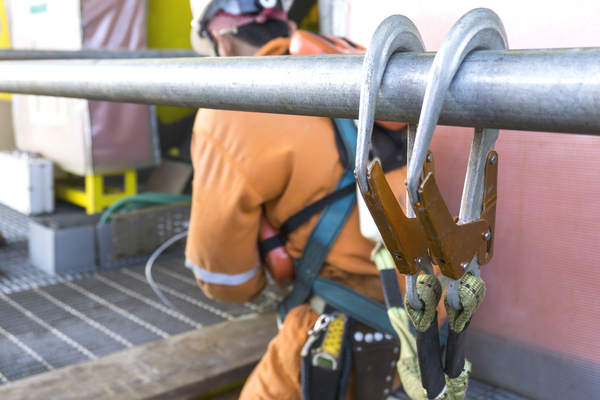Anchors, lifelines, harnesses can be complicated

Fall protection is the subject of large portions of safety regulation. It is made more complicated by having different kinds of fall protection. There are fall arrest systems, work positioning systems and fall restriction systems. It does not even end there. Adding to the complexity, there are also travel restriction and barriers with protection zones.
Fall protection has the unique position of being the subject of some 14 CSA standards. These standards would fill some good size binders. Things get even more complex since we are no longer using simple measures such as weight in kilograms but things are measured in force or shock loading in kilonewtons. Kilonewtons are substantially different from simple weight. Just as a joule measures energy, a newton measures the amount of force. It is kinetic energy and not potential energy.
Even with the basic personal fall arrest system things are not exactly simple. There is the matter of whether there is a straight fall and a fixed anchor or a horizontal lifeline. The forces at work in a horizontal lifeline are substantially more than a regular anchor point, and so they must be designed and certified by an engineer. Even simple anchors have different requirements depending on the structure. Wooden structures are allowed anchor points that will take substantially less force than other anchor points. Of course, a knowledgeable person can take measures to reduce the shock load on an anchor point.
Then there is the lifeline. It could be a lanyard and a separate shock absorber, an integrated unit, or simply a lanyard and a rope grab attached to a lifeline. With the rope grab, there is the inevitable question around what kind of rope should be used. Then there is always the self-retracting lifeline of varying types and capabilities. Choosing the right one can be a bit of a chore.
So now we get to the harness. That seems the easy part, but again looks are deceiving. There are five different kinds of harness. Each is for a specific work type, yet often we ask for a harness or buy some harnesses without making sure that the right one has been selected. Choosing the right harness is, once again, an important decision. Harnesses can be expensive or very reasonably priced. Like with most things you get what you pay for.
Once we get all that done, we have to make sure there is some sort of an annual inspection of the components as they do have a service life and damage or wear is not always obvious. In my experience 35 to 40 per cent of fall protection equipment inspected, where there is not a regular inspection system, is found to be unserviceable. That holds true across several companies in different industries.
Well, now that we at least we have that nailed down, what if someone does fall? After an arrested fall the worker is likely injured and needs immediate assistance. There must be a plan to rescue them and get them to medical assistance. Unless you work very close to a fire department, the rescue plan cannot be to simply call 911. There are a lot of rescue options. Ladders may be an option, local rescue by trained personnel may be available. In some cases, the self-retracting lifelines have a self-rescue option. This is where harness selection may be a telling factor.
So, after walking through all, that you may be wondering what point I am trying to make. The point is simple: everyone needs safety training, especially safety people. Even those who go to some sort of post-secondary education do not get trained in fall protection because it is not everywhere in safety. If safety people need training, what sort of training?
There are three basic levels of fall protection training. Users of fall protection, those who wear and use the fall protection need basic training. This training includes the use of anchors, harnesses, lanyards and shock absorbers. It would include things users need to understand including the daily inspection of the gear and its storage.
There is also training for those who supervise users of fall protection. They need to understand the same things as the users and a bit more on the design of fall protection systems regarding what is appropriate in specific situations. This allows these people to properly and competently supervise those workers using fall protection.
Finally, someone has to design the fall arrest system. Engineers may design and certify anchor points or horizontal lifelines, but they do not really design personal fall protection systems, only the components. Someone must decide which components will be used and how. Safety professionals should understand how the equipment works and what types of equipment are appropriate for each application. They must also know when to get assistance from an engineer, or product representative, to ensure that the system is fitted for the task and that the rescue plan is practical.
If your company uses fall protection, then safety professionals need training on fall protection systems and their design. That must include fall protection, work positioning and fall restriction systems. The fall protection standard, or code of practice, for the company must provide guidance on the harness, lanyard, shock absorber and anchor selection. Safety professionals must understand how the different systems work and the components they may require.
As part of the risk assessment for work, the controls column should not just simply identify fall protection. It must specify the system and the fall a protection plan to ensure the appropriate equipment is selected, worn properly, inspected, and is fit for service.
In looking through any safety supply catalog, many pages are devoted to fall protection equipment. There is even a bag that contains a complete fall protection system (harness, lanyard, and rope grab). It is quite affordable, while other equipment is expensive. Without additional knowledge or training who is to know that such a system is not appropriate for the work at hand?
The safety professional must be involved, and trained, in the design and deployment of fall protection systems. Such training is widely available, and usually, assistance is available from product representatives to some extent. Some of the most common errors I see in the workplace is poor fall protection plans and poor design of fall protection systems. For such a critical discipline, it is incumbent on every safety professional to ensure they are trained, or their staff is trained, on fall protection systems as no else in the company is likely to have that training or expertise.
Workers almost always use the protective systems we put in place for their benefit. We should make sure we are doing our best to ensure those systems are as effective as they can be, by ensuring we have the appropriate training and expertise.






